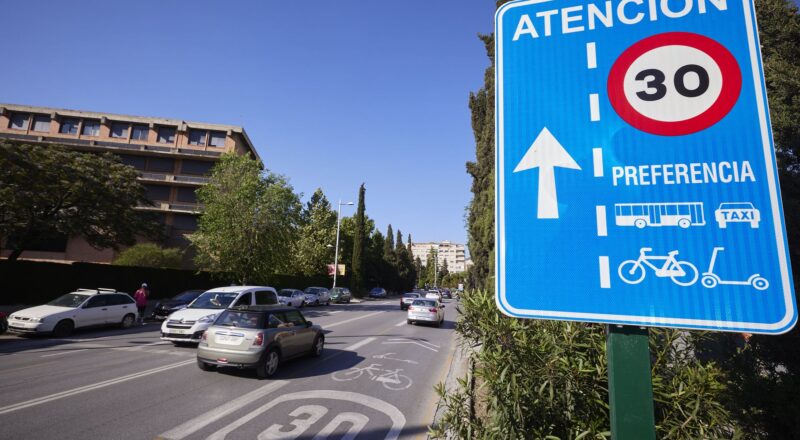More and more cities start to introduce general speed limits, usually of 30 km/h or 50 km/h, in their urban areas. But to what extent is this policy really useful and is it really necessary for cities to implement 30 km/h speed limits like recently introduced in Spain and Madrid? The answer is indeed yes if a city aims to ensure sustainable urban economic development.
The following analysis will focus on effects of speed reduction to 30 km/h in Madrid and why a speed limit of 30 km/h should be more widely implemented. The policy of 30 km/h speed limits will be examined on multiple levels regarding ecology, safety and urban economics.
On November 11th in 2020, the state of Spain announced the crucial changes of law regarding speed limits on Spanish roads, the so-called “Royal Decree 970/2020”. The new rules came in force in May 2021. Content of this are the following generic speed limits on urban roads:
- 20 km/h on roads with a single-carriageway one-lane road
- 30 km/h on roads with a single-carriageway two-lane road
- 50 km/h on carriageways with two or more lanes per direction
Due to the fact that the majority of roads in the city of Madrid fall into the second category, there is usually talk of a 30km/h speed limit.
The ecological advantages of speed limits in urban areas lie on the hand. The slower cars drive, the less they consume gasoline and consequently the lower are pollutant emissions. Two Spanish economists from the University of Barcelona examined the effects of variable speed limits on air pollution in the metropolitan area of Barcelona and found out that this policy NOX and PM10 values which are pollution gasses greatly decreased while the effect of a 30 km/h speed limit in urban areas is similar. One can argue that this effect is indeed even greater due to the fact that people tend to switch their means of transport more likely than on highways or comparatively bigger roads.
When it comes to safety the logic of speed limits is obvious. The dangers of driving cars are significantly lower when driving with less speed. The Dirección General de Tráfico (DGT), a Spanish organization with the purpose of increasing road users’ security, the fluidity of vehicle circulation and the provisions to citizens of related services, examined traffic accidents in Spain. According to their research, there is indeed a correlation between seriousness of accidents and the speed as the accident occurred. As shown, in nine out of ten incidents where the vehicle drove with a speed of more than 50 km/h, the victim loses their life while this only happens to ten percent of the incidents where the vehicle speed was less than 30 km/h. As the expert from the Public Health Agency in Barcelona Catherine Pérez stated, “the impact of the 30 km/h zones will go beyond deaths and serious injury”. Spanish scientists from the University of Burgos and University of the Basque Country analyzed the security-related effects of the introduced speed limits and have come to the following conclusions. The stopping time when driving exponentially increases at higher speed as does the probability of death in the case of an accident.
From the urban economic perspective, it can be stated that a policy like generic speed limits incentivizes away from using cars and instead towards switching to alternative means of transportation like public transport, bike or even walking. In order to ensure sustainability as well as environment protection, an urban economic refocus is of fundamental importance meaning an increase in the use of public transport, especially rail based systems like subways but also bicycle or if possible walking. Furthermore, micro-mobility approaches like scooter-sharing providers begin playing an increasingly important role. At the same time, cars as traditional means of transport become less attractive and important for the urban population. Measurements like a speed limit lower the incentive of car use and are therefore crucial for the concentration away from a primarily car-focused infrastructure and transportation system.
Opponents of policies like urban speed limits often refer to intervening in rights and stress personal responsibilities instead of bans and prohibitions. In Germany which is the home country of the author and also the only country in the world with no generic speed limit on highways the debate about highway speed limits intensified in the last years. The argumentative approach of opponents of highway speed limits is similar to the one of the opponents of urban speed limits. They usually refer to the relevance of self responsibility and stress the moral level of this debate. Indeed, individual liberty and self responsibility are fundamental and preservable values but still, the argumentation approach is not the right one when it comes to debates like this. It directs the focus away from a rational measurable-based debate towards a disproportionate and irrational value-based discussion that does not cause (urban) economic development.
One can finally state that the scientific base for the debate about speed limits in urban areas is obvious. A refocus away from a car-centered urban infrastructure in terms of means of transport is necessary to deal with upcoming challenges of urban economics which are among multiple others pollution and locomotion within the urban areas. Spain has shown with the institution of generic speed limits in its cities how pollution can be greatly reduced and the switch to alternative means of transport like public rail-based transport as well as bicycles or micro-mobility approaches can be incentivized. Now further implementation is necessary in more cities to achieve sustainable urban economic development. It is therefore of fundamental value that cities provide sufficient possibilities for alternative means of transport when implementing speed limits in urban areas. This includes public transport, especially rail-based public transport systems, as well as bicycle roads and micro mobility availability.
References
Abad Liñán J. M. (2021) In bid to reduce road deaths, Spain rolls out 30km/h speed limit on most urban streets https://english.elpais.com/spanish_news/2021-05-11/in-bid-to-reduce-road-deaths-spain-rolls-out-30kmh-speed-limit-on-most-urban-streets.html
Bel G., Rosell J. (2013) Effects of the 80 km/h and variable speed limits on air pollution in the metropolitan area of barcelona https://www.sciencedirect.com/science/article/abs/pii/S1361920913000680
Dirección General de Tráfico https://www.dgt.es/conoce-la-dgt/quienes-somos/nuestros-valores/
Gonzalo-Orden H., Rojo M., Unamunzaga A. L., Aponte N., Pérez-Aceba H. (2021) Why is necessary to reduce the speed in urban areas to 30 Km/h? https://www.sciencedirect.com/science/article/pii/S2352146521007882
The Local es (2021) Why you now have to drive at 30km/h on most roads in Spainhttps://www.thelocal.es/20210419/reminder-why-you-will-soon-have-to-drive-at-30km-h-on-most-roads-in-spain/












































I strongly agree with your point that the introduction of a lower speed limit, 30 kph, is a good idea within cuty centres. Firstly I feel confident the section of people who will switch away from cars and to alterantive modes of transport will be very significant. Secondly I want to emphasize the importance of safety through the example of the city from my home university Tilburg. I was personally envolved in an accident where I was hit by a car because he was driving at excessive speeds. There have been a lot of talks in Tilburg about the importance of lowering the speed limit in the area. And this is for good reason because within a two week period there were 3 more cases, one of which lethal in the in the same area.
Interesting article, even though it might be an unpopular switch for many people, I believe it is necessary to increase the importance of safety and environmental matters. Perhaps cities should already embrace micro-mobility more before implementing such rules. If you look at Madrid, for example, it is very difficult to drive a bike there because of the lack of bike lanes, hence also affecting the safety of people. Overall, this is a well-structured article, and it is an important point to address.
As a regular bike rider in my city, I am aware of the danger of car speed in urban centers. As you said, I believe this lower speed limit will have many positive consequences, not only in regards to safety but also to environmental issues. By giving incentives to car owners to use other ways of transportation, cities can turn greener and safer, but to the extent that in parallel, local authorities extend the public transport offer, for instance with more bike lanes, shared scooters and overall a better access to transport.
Very interesting article! However, what Daryl mentions is interesting about what does Madrid offers as a solution. There are barely bike lanes, for example. It would be interesting to research when people would accept the 30 km/h implementation. For example, do they demand good bike lanes or very good infrastructure so that they have another option, etc. Overall a really interesting and well-structured article!